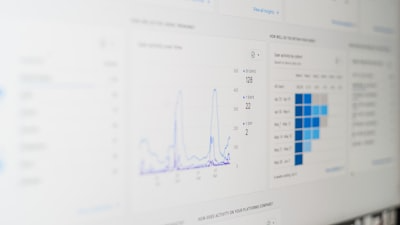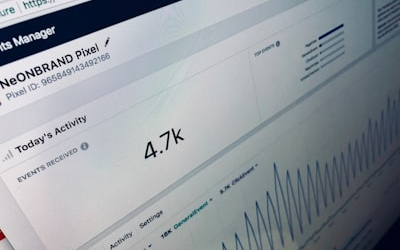Content marketing KPIs are not just numbers; they are your digital pulse check. Imagine a heartbeat monitor for your brand’s online presence.
Every blip is a story—a tale of interaction, interest, or indifference.
Marketing KPIs (Key Performance Indicators) offer that insight but are tailored to measure success across various channels.
We’ve all heard “What gets measured gets managed.” Now apply that to content creation.
Without tracking these indicators, it’s like walking blindfolded toward your goal—hopeful but directionless.
A stark reality hits when considering only measurable values can guide strategies effectively—making every blog post count more than ever before.
Vital Summary:
- Key Performance Indicators (KPIs) in content marketing are like an aid in likening them to vital signs that monitor the health of your online presence.
- Tracking KPIs provides clarity on what attracts clicks and conversions, aids decision-making in content creation, and fuels growth by identifying high-performing content.
- Measuring brand awareness, tracking organic website traffic, and social shares are indicators of brand visibility and engagement, emphasizing their role in content strategy optimization.
- Strategies for enhancing engagement through compelling storytelling and addressing audience pain points are highlighted, along with the importance of tracking conversion KPIs.
- Tools like Google Analytics and platforms for email marketing, emphasize the need to analyze data regularly to optimize content strategy and measure ROI effectively.

What Are Content Marketing KPIs?
Ever wondered how to prove your content marketing is worth its salt? Enter Content Marketing KPIs.
These are the beacon lights guiding your strategy, shining bright on what’s working and what’s not.
They’re not just numbers; they’re insights into how well your content connects with your audience.
KPIs are essentially the vital signs that monitor the health of your content marketing endeavors.
Think of them as pulse checks for your content marketing efforts.
From blog posts to e-books, these indicators help you track everything that matters in content marketing.
The Importance of Tracking KPIs in Content Marketing
You wouldn’t drive blindfolded, right? So why fly blind with your content strategy? That’s where tracking comes into play.
- Gives clarity: You get a clear picture of what attracts clicks and conversions.
- Aids decision-making: It helps you decide where to double down or cut back.
- Fuels growth: By understanding which pieces perform best, you can produce more winners.
Making sense of metrics like website traffic or social shares gives you real power – the power to refine and perfect every piece of content out there.
And let me tell ya, when it comes to boosting those conversion rates or increasing brand awareness – nothing beats knowing exactly where you stand with solid data backing up every move.
To dive deeper into why these performance indicators are game-changers in our digital world, check this out.
Whether it’s engagement on social media platforms or organic search visibility thanks to SEO efforts – each indicator serves a unique purpose toward achieving business goals through compelling storytelling and relevant information sharing online.
So yeah, if we’ve got our sights set on making an impact, getting cozy with KPIs in content marketing is pretty much non-negotiable.
Let’s use those insights as stepping stones towards crafting strategies that don’t just look good on paper but deliver jaw-dropping results.
Setting Goals for Your Content Strategy
How to Define Clear Marketing Objectives
Defining clear marketing objectives isn’t just about saying, “We want more eyeballs on our site.”
It’s about digging deep and asking, “What do we want to achieve?” Do you want to boost your brand awareness?
Increase sales by 20%? Grow your email list by thousands.
The trick is in the specificity. The clearer you are with what you aim to accomplish, the easier it will be to measure success.
Aligning Content Strategy with Business Goals
This part is crucial. Your content strategy should be like a well-oiled machine working tirelessly towards your business goals.
If one of those gears – say, content marketing – spins out of sync, it throws everything off balance.
- If your main goal is lead generation,
- Your blog posts should magnetize potential clients and make them think, “Where have you been all my life?”
- Social media content needs not just any engagement but interactions that guide followers down the sales funnel.
- Email campaigns must seduce subscribers into clicking through and sealing the deal.
In essence, “Every piece of content should whisper sweet nothings into the ears of your target audience.”
To wrap this up nicely – set ambitious yet achievable goals that resonate deeply with what matters most; growth & impact. And remember, “Goals without action are just pretty words on paper.”
Action here means consistently measuring progress against these markers using key performance indicators (KPIs).
Only then can we truly see how far we’ve come…and where there’s still room for improvement or optimization within our content strategies.
Key Performance Indicators for Brand Awareness
When we talk about brand awareness, it’s all about getting your name out there, right?
But how do you know if you’re really making waves or just splashing around in the kiddie pool?
The answer is simple: organic website traffic. This gem tells you how many folks found your site by simply typing a query into their search bar and clicking on your link—no ads involved.
The beauty of tracking organic traffic is that it gives you a clear picture of how well your SEO game is working to increase brand awareness.
Seeing an uptick in visitors? This signifies that folks are catching wind of your presence and are eager to delve deeper into what you offer.
And let’s be honest, who doesn’t love seeing those numbers climb?
Here’s why measuring organic traffic matters.
Tracking Social Shares and Engagement
Social media is like the town square of our digital age—a place where news spreads fast and opinions matter.
So when someone shares your content, it’s akin to them shouting from the rooftops that they dig what you’re doing.
Social shares and engagement are not just vanity metrics; they’re solid indicators that people not only know who you are but also find value in what you provide enough to pass it along.
Think retweets, likes, comments—the works. It’s social proof at its finest. And here’s the kicker: The more engaged people are with your brand online, the higher chances they’ll remember—and prefer—you when decision time rolls around.
Enhancing Engagement Through Content Marketing
Let’s face it, nobody wants their site to be a ghost town. That’s where bounce rate and average time on the page come into play. These engagement KPIs are like the pulse of your website engagement.
Is the bounce rate too high? It might mean your content isn’t sticky enough or maybe it’s not what people expected when they clicked through.
And if visitors vanish faster than a magician at curtain call, you need to rethink your content strategy.
The average time on the page tells its own story. It subtly hints at whether your content is enchanting or failing to hold interest.
If folks stick around, reading every word as if it’s the last piece of chocolate in the box, you’re doing something right.
Utilizing Social Media Metrics for Better Engagement
Social media metrics aren’t just numbers; they’re signposts guiding you toward better engagement with your audience.
- Likes: They’re good for ego but dig deeper—what content earns that thumbs up?
- Shares: Now we’re talking. Shares mean someone found value in what you said so much so that they put their stamp of approval on it by passing it along to others.
- Comments: This is gold—the dialogue starts here. This shows active participation from readers who felt compelled to add their two cents.
Craft content that lights up smiles, provokes reflection or prompts a call to arms. Remember: relevance trumps virality every day.
To nail this, measure social media engagement KPI wisely. Be picky with what success looks like for each campaign, and tweak until those metrics sing songs of triumph in harmony.
So yes, you can boost website and social media engagement, but only if armed with data and creativity. Don’t let vanity metrics lead you astray.
Focus instead, on creating meaningful connections with audiences because ultimately, it’s these relationships that fuel conversions, and keep brands thriving in today’s digital age.

Evaluating ROI in Your Content Campaigns
Let’s face it, diving into the numbers can sometimes feel like you’re trying to decode an ancient language.
Yet, grasping the nuances of your promotional outlay and its influence is vital, lest we navigate blindly.
So, let’s break down that wall of confusion with some straightforward talk about ROI calculation.
To start, calculating the ROI of your content campaigns isn’t just important—it’s essential for knowing whether you’re throwing a party where no one shows up (aka spending money without seeing any return) or hosting the event of the season (meaning you’re getting more bang for your buck).
The formula looks something like this: (content marketing revenue – content marketing cost) / content marketing cost. Simple enough? This gives you a percentage that tells you exactly how effective your investment has been.
Balancing Budget and Performance in Campaign Planning
A tightrope walker doesn’t just hop on the line without a plan; they know every step before making their move.
Similarly, balancing budget and performance needs careful consideration—like planning which wire to walk on based on both risk and reward.
- Analyze past performances: Look back at what worked well (and what didn’t). Drawing from past experiences, let these lessons shape the allocation of your upcoming financial plans.
- Prioritize strategies: Put your money where it matters most. If social media brings in the most leads, maybe shift more funds there.
- Maintain flexibility: The digital world changes fast. Be ready to reallocate resources as needed to stay ahead of trends.
- Optimize continuously: Fine-tuning campaign elements based on ongoing data analysis ensures better outcomes over time.
In essence, think of yourself as a savvy investor rather than just someone spending money hoping for results.
By being strategic about where each dollar goes and measuring its impact meticulously through performance metrics, you’ll not only see better returns but also improve overall efficiency in your content campaigns.
Remember, the goal is sustainability—not just short-term gains but building lasting value that keeps paying off long after initial efforts are done. And who wouldn’t want that?
Conclusion
So, we’ve journeyed through the digital pulse of our brand’s online presence and uncovered the secrets behind content marketing KPIs. Without such navigational beacons, where would we be?
Now armed with knowledge and tools sharper than ever before, each post is not just a shout into the void but a beacon guiding your audience home.
Content marketing KPIs are not just numbers; they’re stories waiting to be told. They’re opportunities hiding in plain sight. And now? You’ve got the map to find them.
Crafting our messages isn’t merely about occupying voids or meeting benchmarks; it’s an endeavor to imbue each phrase with significance that transcends mere personal gain.
It’s transforming silent spaces into forums buzzing with life because that’s what happens when strategy meets soul.
Today, you didn’t merely skim through another piece; instead, you ventured deeper into the realm where analytics intertwine with narrative, honing a craft that lies at the heart of innovation and expression.
Feel accomplished because today you learned how to turn metrics into milestones on your journey toward unparalleled growth.



